Gallery of Illuminating and Inspirational Integrative Practices in Higher Education
The following cases (and other examples embedded throughout this report) are representative samples of a wide range of possible outcomes from integrative artistic practices that are connected to higher education, including programs, courses, and collaborations. Although not an exhaustive list, they reflect diverse approaches and applications to integration, and the various modes and pathways that different disciplines can use to inform one another to produce a myriad of results, outcomes, synergistic impacts, and localized, as well as far-reaching, potential benefits. Examples include a range of research projects, performative- and exhibition-based work, curricular and co-curricular endeavors, and community-engaged projects. Categories include citizen science, science communication and engaged research; therapeutic interventions and storytelling to inform innovation, healing, and discovery; exhibition and installation; venture creation; and aesthetic, as well as scientific explorations in the lab, with new media, and through traditional, as well as nontraditional, performance venue environments. These examples are from U.S.-based projects and are affiliated with academic institutions demonstrating curricular, co-curricular, and research-based integrative models and pathways (see Compendium of Programs and Courses on the Integration of Humanities, Arts, and STEMM at nap.edu). The committee maintains that the impact of certain forms of knowledge creation cannot be sufficiently described in words or numbers.
Some of these examples are drawn from work compiled by:
SEAD at https://seadexemplars.org/
SEAD steering group: Roger Malina, Carol Strohecker, Robert Thill, Nicola Triscott, Robert Root-Bernstein, Carol LaFayette, and Alex Garcia Topete.
And XSEAD at http://xsead.cmu.edu/
Thanssis Rikakis (Principal Investigator, Vice Provost for Design, Arts and Technology + School of Design), Aisling Kelliher (Senior Personnel, School of Design), and Daragh Byrne (Lead Developer, School of Design)
KINETROPE: CREATING CROSS-DISCIPLINARY SPACES TO PROMOTE DISCOVERIES AND CHANGED PERSPECTIVES
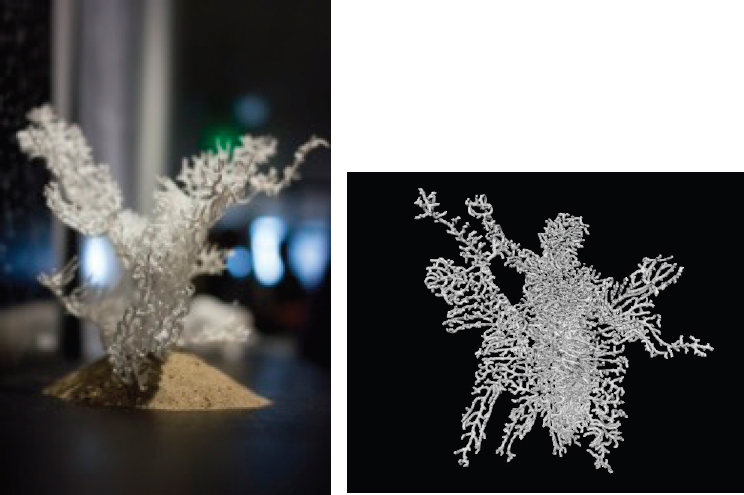
Project name: Kinetrope (2015)
Created by: Timothy Wood (Ph.D. Student, transLAB, Media Arts and Technology, University of California, Santa Barbara)
The transLAB (The Transvergent Research Group) is a research facility whose mission is to investigate how technology alters the relation between actual, transactivated, and virtual space in art and science by bringing together diverse expertise to investigate areas such as worldmaking, trans-modality, computational composition, algorithmic aesthetics, n-dimensional space, space as interface, and more. For example, Kinetrope is a plant-like life form born in virtual space that grows toward the motion of another. In reality there are many types of tropisms that give plants the impulse to grow and to be shaped in specific and unique ways. Through the creation of this specific growth algorithm and a new type of tropism, the possibilities of relationships and choreographies across boundaries becomes possible.
Timothy Wood (fishuyo@mat.ucsb.edu)
Project website: http://fishuyo.com/projects/kinetrope/transLAB website: http://translab.mat.ucsb.edu
CITIZEN SCIENCE/CITIZEN ARTIST AND COMMUNITY ENGAGEMENT
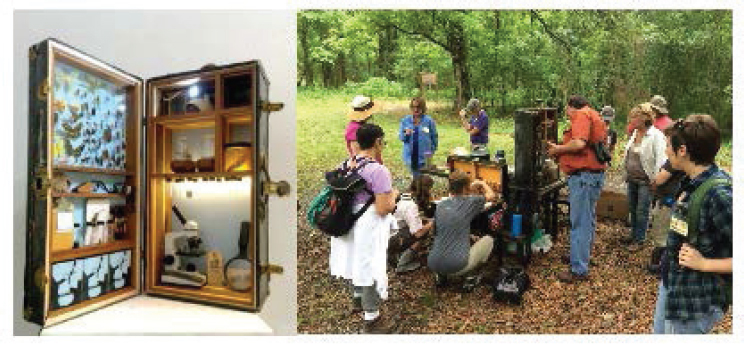
Crude Life Portable Museum: A Citizen Art and Science Investigation of Gulf of Mexico Biodiversity after the Deepwater Horizon Oil Spill
Brandon Ballengée (Louisiana State University); Prosanta Chakrabarty (Louisiana State University); Sean Owen Miller (University of Florida); and Rachel Mayeri (Harvey Mudd College)
Crude Life is an interdisciplinary art, science, and outreach project focused on gathering data on endemic fishes affected by the 2010 Gulf of Mexico Oil Spill. This engagement project raises public awareness of local species, ecosystems, and regional environmental challenges through community “citizen science” surveys and a portable art-science museum of Gulf of Mexico and Acadiana regional biodiversity. A project focus is engaging area fishers and other community members to look for 14 missing species of endemic Gulf fishes that have not been found following the spill.
PERFORMANCE AS PLATFORM FOR BUILDING BRIDGES BETWEEN DISCIPLINES
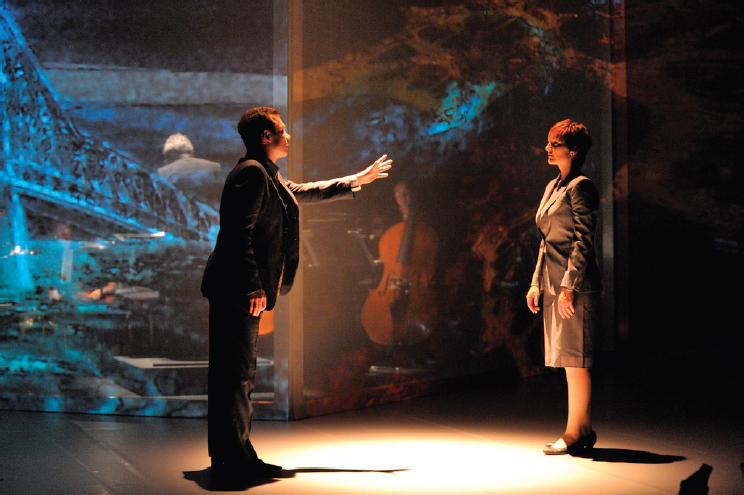
Hypermusic Prologue: A Projective Opera in Seven Planes
Lisa Randall (Harvard University) and Hector Parra (composer)
SOURCE: https://seadexemplars.org/portfolio_page/hypermusic/
Hypermusic is a project that demonstrates how music and storytelling can come together to facilitate a better understanding of science. The multi-dimensional opera brings together music, performances, and story to represent a new model of space-time based on contemporary research and theory. This opera was designed to disseminate the basic principles of Professor Lisa Randall’s space-time model among the physics community and the artistic world. According to the SEAD website, “the intent of Hypermusic was to make a new scientific concept—a new space-time model—more understandable for fellow physicists and other scientists while also experimenting with the music and storytelling.”
IMAGINING A BETTER FUTURE THROUGH CREATIVE WRITING
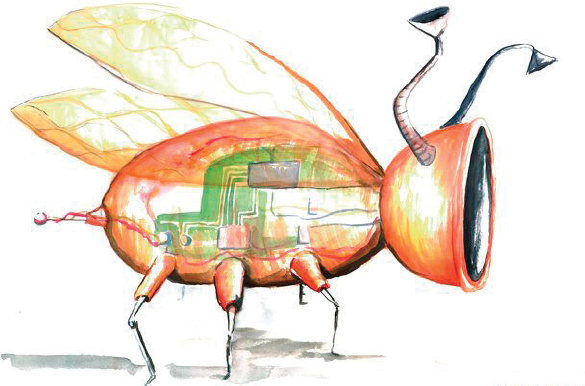
Hieroglyph: Stories and Visions for a Better Future
Illustration for the story “Johnny Appledrone vs. the FAA,” in Hieroglyph: Stories and Visions for a Better Future. Edited by Ed Finn (Arizona State University) and Kathryn Cramer (writer).
Illustration by: Haylee Bolinger (https://www.hayleebolinger.com)
SOURCE: https://seadexemplars.org/portfolio_page/hieroglyph/
Hieroglyph is a project of Arizona State University’s Center for Science and the Imagination that curates the innovative work of writers and researchers, bringing together top science fiction authors with scientists, engineers, and other experts to collaborate on futuristic visions grounded in real insights from science, technology, and a wide range of other disciplines. According to Project Hieroglyph’s website (http://hieroglyph.asu.edu), “certain iconic inventions in science fiction stories serve as modern hieroglyphs.” Hieroglyph’s first anthology, Hieroglyph: Stories and Visions for a Better Future, features 17 original stories born from these collaborations, demonstrating how art and storytelling can rekindle our grand ambitions for the future. The book includes innovative proposals such as 3D printing in space, an alternative internet powered by drones, solar cities designed to mimic algae cells, and more. The book sparked a national conversation throughout news outlets about the role that science fiction plays in igniting the public’s imagination and bridging our present with the future. This project has served as a model for futurism and its power to shape innovation.
CULTURAL DISPLAY OF THE INTEGRATION OF ART AND SCIENCE
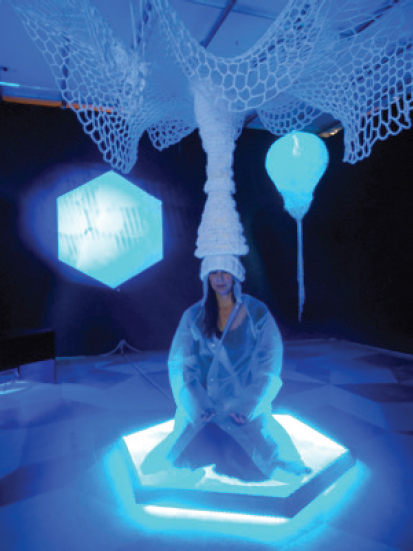
Blue Morph
Victoria Vesna (University of California, Los Angles); James K. Gimzewski (University of California, Los Angles)
SOURCE: http://artsci.ucla.edu/BlueMorph
BLUE MORPH is an interactive installation that uses nanoscale images and sounds derived from the metamorphosis of a caterpillar into a butterfly. According to the artist’s website, “Nanotechnology is changing our perception of life and this is symbolic in the Blue Morpho butterfly with the optics involved—that beautiful blue color is not pigment at all but patterns and structure which is what nano-photonics is centered on studying. The lamellate structure of their wing scales has been studied as a model in the development of fabrics, dye-free paints, and anti-counterfeit technology such as that used in monetary currency.” Victoria Vesna is the Director of the Art|Sci center at the School of the Arts and California Nanosystems Institute (CNSI). James Gimzewski is a Distinguished Professor of Chemistry at the University of California, Los Angeles and Director of the Nano & Pico Characterization Core Facility of the California NanoSystems Institute.
CREATION OF SOLUTIONS THAT IMPROVE LIVES AND CREATE NEW INDUSTRY MODELS
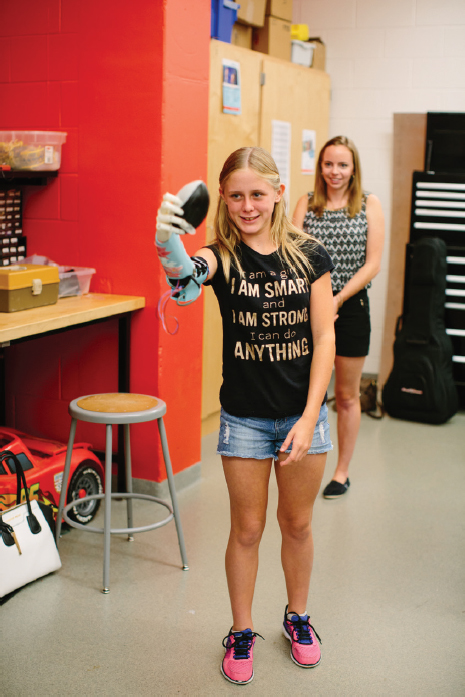
Limbitless Solutions
Albert Manero, President (University of Central Florida)
Annika Emmert using Limbitless Solutions’ flower arm.
Limbitless Solutions is a nonprofit organization that uses 3D printing to create personalized bionics and affordable prosthetics. The organization grew out of work that the founding team members did as students at the University of Central Florida. According to group’s website, the organization is “devoted to building a generation of innovators who use their skills and passion to improve the world around them. . . . We believe that no family should have to pay for their child to receive an arm. Now we want to lead by example and encourage communities to innovate with compassion.”
CREATING RESEARCH FACILITIES THAT ARE IMMERSIVE AND TRANSDISCIPLINARY
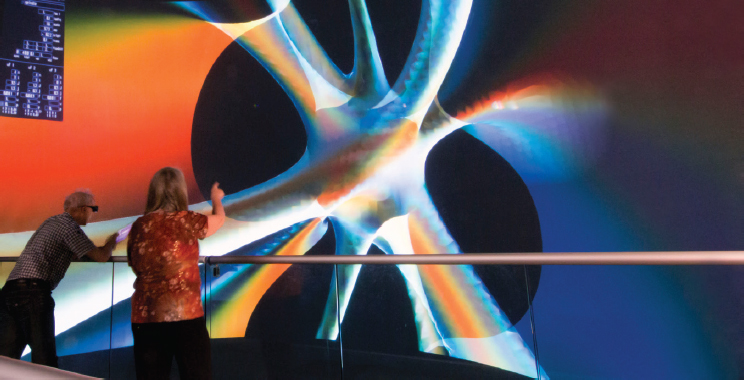
AlloSphere
Dr. JoAnn Kuchera-Morin
Director, AlloSphere Research Group
Professor, Media Arts and Technology
Professor, Music
University of California, Santa Barbara
This image shows researchers controlling parameters of real-time visualization of a hydrogen-like atom on the AlloSphere bridge. The AlloSphere, a 30-foot diameter sphere built inside a three-story near-to-anechoic (echo free) cube, facilitates research collaborations in an environment that can simulate reality. The AlloSphere allows use of multiple modalities to represent large and complex data, incluing immersive visualization, sonification, and interactivity. According to the AloSphere website, “We are creating technology that will enable experts to use their intuition and experience to examine and interact with complex data to identify patterns, suggest and test theories in an integrated loop of discovery. Important research areas include quantum information processing and structural materials discovery, bioengineering and biogenerative applications, and arts and entertainment.” Dr. Kuchera-Morin serves as the Director of the AlloSphere Research Facility at the University of California, Santa Barbara.
CREATING ROBOTIC AND PLANT LIFE INTERFACES
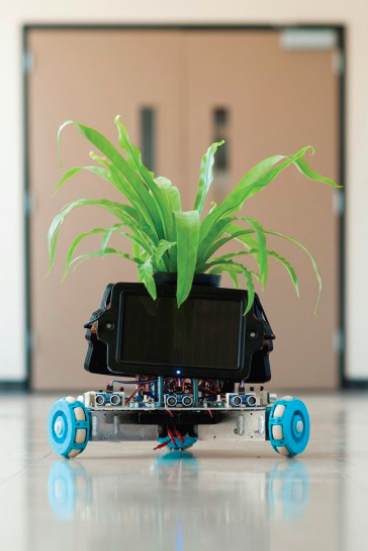
The IndaPlant Project: An Act of Trans-Species Giving
Elizabeth Demaray (Rutgers); Qingze Zou (Rutgers); Simeon Kotchoni (Rutgers); and Ahmed Elgammal (Rutgers)
SOURCE: https://seadexemplars.org/portfolio_page/indaplant-project/
The IndaPlant Project is designed to facilitate the free movement and metabolic function of ordinary houseplants. It merges plants and robots in a way that creates an automated environment focused on the nurture of the plants. IndaPlant required adapting innovations from computer science and robotics in order to decode the plant-generated bio-information, and model solutions that allowed the plant-robots to seek sunlight and water. The floraborg (a term to describe an entity that is part plant and part robot) could allow for automated biodomes that would benefit plants and humans. Addressing the super sensory capacities of plants, this interface allows humans to decipher plant-based information on ecosystem health, the effects of climate change, and air pollution.
PIONEERING INTEGRATION AND THE CREATION OF NEW INDUSTRIES
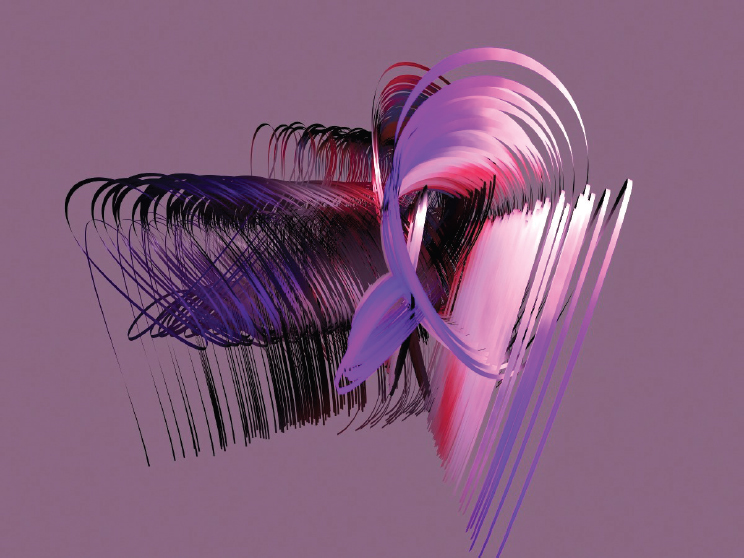
Ordo 211
Charles Csuri (Ohio State University)
Charles Csuri is an artist who has pioneered new technologies that have led to the creation of new industries. Csuri’s pioneer research in computer graphics and animation has not only been applied to flight simulators, computer-aided design, visualization of scientific phenomena, magnetic resonance imaging, education for the deaf, architecture, and special effects for television and films, but also helped establish leading educational programs that trained the new professionals. His former students have worked for Industrial Light and Magic, Pacific Data Images, Metro Light, Pixar, Rezn8, Silicon Graphics Inc., USA Today, Rhythm and Hues, Xaos, Walt Disney Productions, and others.
COLLABORATION AND AESTHETICS
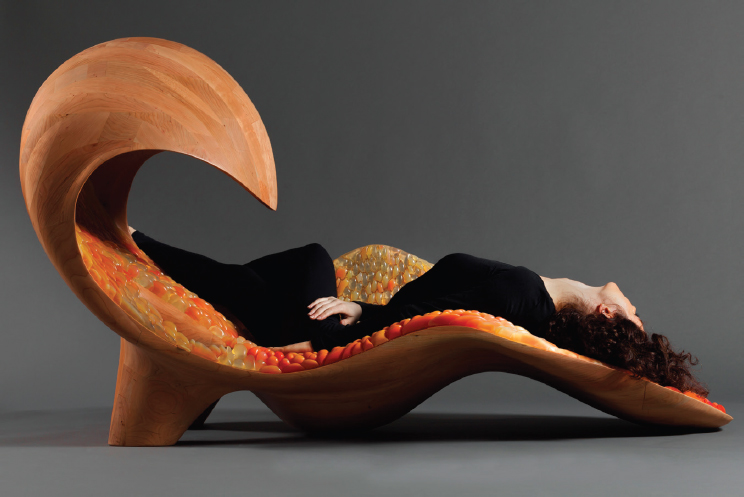
Gemini (Permanent Collection at SFMOMA)
By Neri Oxman (MIT Media Lab)
In collaboration with Stratasys and Prof. W. Craig Carter (Department of Materials Science and Engineering, MIT)
Paris, 2014
Photo: Michel Figuet
The design of Gemini—an acoustical “twin chaise”—“includes a number of length scales ranging from structure to material composition that affect its sound absorbing properties: (1) On the meter scale, the chaise forms a semi-closed anechoic-like chamber with curved surfaces that tend to reflect sound inward. The surface structure scatters the sound and absorbs it and, in the absence of large planar surfaces, reduces the amount of sound that would otherwise bounce back to the source; (2) On the centimeter scale—a scale that corresponds to the wavelength of sound—the 3D printed inner ‘skin’ is designed as 3-dimentional doubly curved cells that scatter and absorb sound effectively given their geometry (i.e. the sound tends to bounce from one ‘cell’ unit to another till it gets absorbed) and high surface
area to volume ratios. The features of the chaise are on the order of the wavelength of sound and they therefore interact strongly with sound and get absorbed effectively; (3) On the nano-scale, the properties of the Digital Materials also contribute to the absorption of sound. These materials are elastic in nature, varying in durometer (and sound absorption) as a function of curvature. Surface areas that are more curved than others are also assigned more elastic properties, thereby increasing absorption around local chambers,” according to Oxman’s Material Ecology website (http://www.materialecology.com/).
EXPLORING THE INTERCONNECTIONS BETWEEN BIOLOGY AND SOCIOLOGY
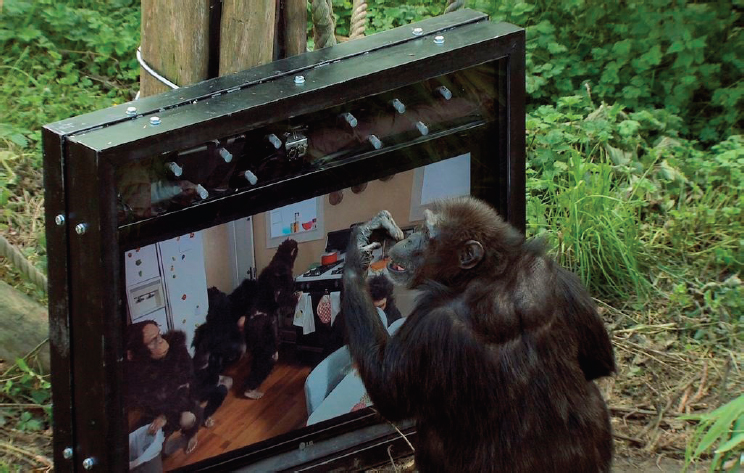
Ape Cinema
Rachel Mayeri (Harvey Mudd College)
SOURCE: https://seadexemplars.org/portfolio_page/ape-cinema/
Ape Cinema utilizes how common human practices can become means to explore other fields. The project consists of an original movie made expressly for a chimpanzee audience, who seem to be watching the same things as human primates: dramas around food, territory, social status, and sex. The project creates a prism for human beings to learn more about the complex social, cognitive, and emotional lives of chimpanzees by watching a movie through chimps’ eyes.
ANIMATING RESEARCH AND ACTIVATING SPACES OF KNOWLEDGE PRODUCTION
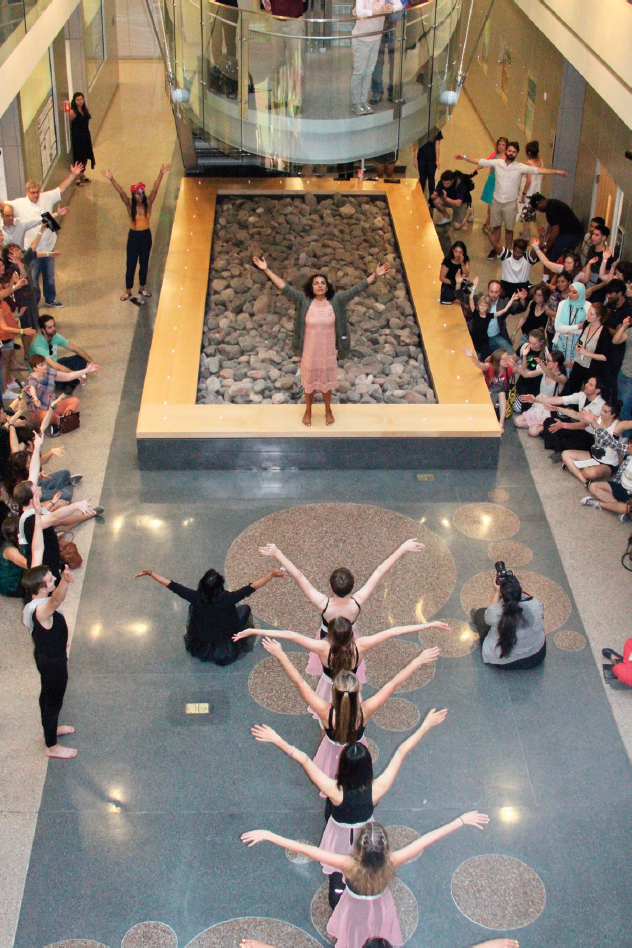
As part of Liz Lerman’s Animating Research class, students lead a participatory moment during a performance at the Biodesign Institute at Arizona State University (2017)
Credit: Deanna Dent/ASU Now
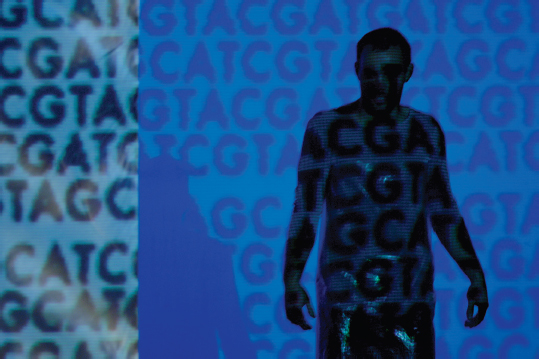
Performer Matt Mahaney in Liz Lerman’s evening-length work Ferocious Beauty: Genome (2006).
Credit: Kevin Kennefick
Choreographer, MacArthur Fellow, and Institute Professor at Arizona State University (ASU), Liz Lerman created her “Animating Research” course to combine contemporary movement, dance, theater, and science into multimedia, immersive experiences for audiences and performers: a dozen artists were paired with molecular virologists, evolutionary biologists, and engineers to create mini-performances using and exploring ASU’s biodesign building space. Lerman developed her process over decades of creative research through multidisciplinary works including her “science trilogy”: Healing Wars (2014); The Matter of Origins (2011, with support from the National Science Foundation); and Ferocious Beauty: Genome (2006), created in collaboration with dozens of geneticists and educators, exploring how knowledge of the genome changes the way we think about aging, perfection, ancestry, and evolution.
INSPIRING NEW INNOVATION THROUGH TRADITIONAL PAPER TECHNIQUES
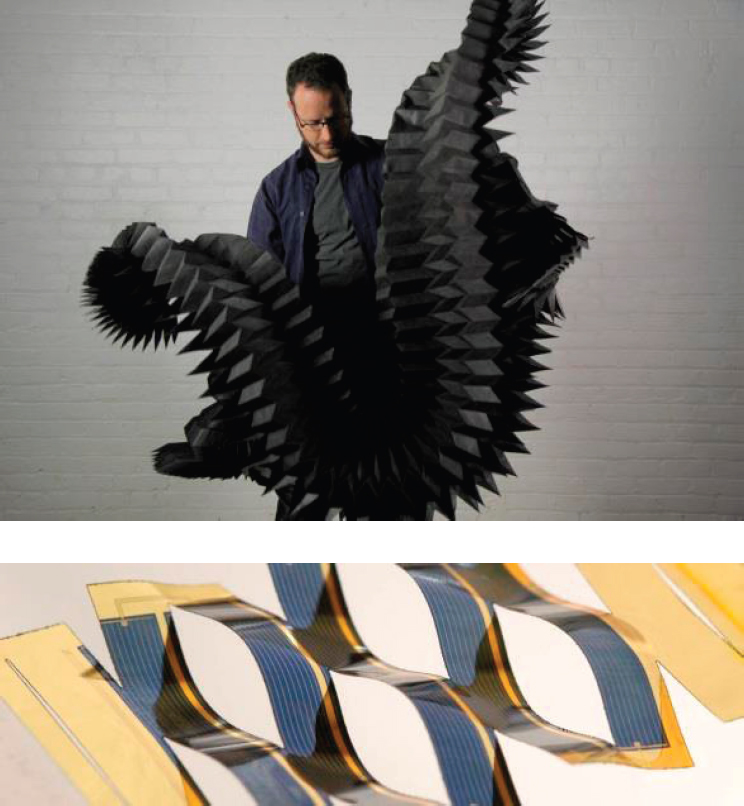
Kirigami Inspired Elastic Solar Cells Model
Image of dynamic kirigami structure capable of solar tracking, consisting of monolithically integrated, single crystalline yet flexible, gallium arsenide solar cells on polyimide sheets. Work credit: Aaron Lamoureux, Kyusang Lee, Matthew Shlian, Stephen Forrest, Max Shtein—University of Michigan Image credit: Aaron Lamoureux—University of Michigan
Matthew Shlian is an artist and designer working in paper using the traditions of origami, kirigami, and paper engineering to transform flat materials into 3D sculptures. Shlian, in collaboration with Max Shtein, material scientist and engineer at the University of Michigan, Ann Arbor, began exploring the question, “Can we make solar cells more efficient by using paper folding and cutting techniques?” The limitation of stationary solar panels is that they are only at maximum efficiency for a limited amount of time during the day. Normal solar tracking mechanisms are prohibitively bulky, heavy, and expensive for use on rooftops. Working together with the Stephen Forrest Group (an electrical engineer, also at the University of Michigan) and graduate students Aaron Lamoureux and Kyusang Lee, they developed solar cells made from thin-film crystalline gallium arsenide bonded to thin foils. The foils were then laser-cut into patterns inspired by kirigami, which allowed them to adjust the angle of the solar cells simply by stretching the kirigami sheet. As a result, exposure to the sun is maximized and electricity production is boosted significantly.
FOSTERING CREATIVE PROCESSES TO ADVANCE EXPLORATION AND EXPRESSION
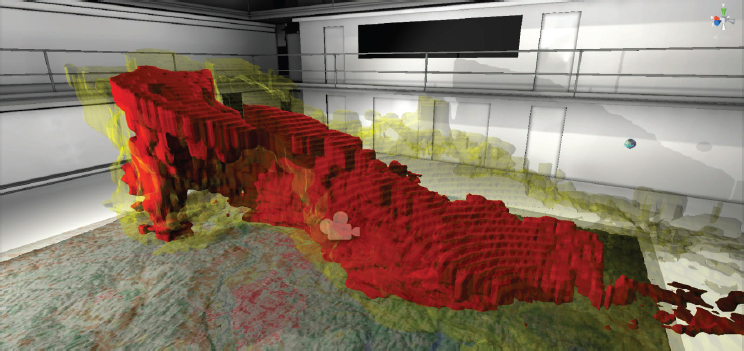
Tornado Project
The Cube
Bill Carstensen, David Carroll, Drew Ellis, Peter Sforza
Virginia Tech
Utilizing the technology made available at The Cube at Virginia Tech, the team created a 3D meteorological immersive experience of a tornado. According to the website, “The full scientific potential of radar data is not normally realized simply because current radar visualization is rather basic —typically on a flat screen on which, at best, static 3-D representations are rendered.” The Cube is a four-story-high, state-of-the-art theatre and high-tech laboratory that serves multiple platforms of creative practice by faculty, students, and national and international guest artists and researchers. The Cube is a highly adaptable space for research and experimentation in big data exploration, immersive environments, intimate performances, audio and visual installations, and experiential investigations of all types. This facility is shared between ICAT and the Center for the Arts at Virginia Tech.
CROSS-DISCIPLINARY COLLABORATION FOR COMMUNITY IMPACT
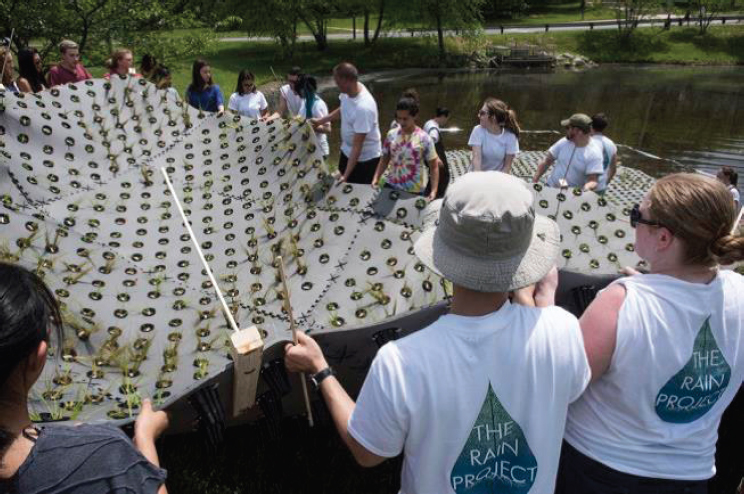
The Rain Project
Changwoo Ahn (George Mason University) EcoScience+Art
Photo by Evan Cantwell/Creative Services/George Mason University
SOURCE: https://www.changwooahn.com/ecoscience--art
EcoScience+Art is an initiative and collaboration between the arts and sciences at George Mason University with a mission to bring together individuals working across the boundaries of ecosystem science, art, and design fields to share knowledge, expertise, and strategies for creatively engaging in the common pursuit of a sustainable future. The Rain Project is a floating treatment wetland on Mason Pond. Students participate in a project-based learning approach aimed at developing innovative interdisciplinary education and scholarship. The goal is to raise awareness of critical stormwater issues for the Mason community, by means of a year-long project (Fall 2014 through Fall 2015) in which science collaborates with engineering, arts, and humanities in order to design and implement a floating wetland in Mason Pond.
INVESTIGATING BIOLOGICAL SCIENCES AND DIGITAL TECHNOLOGIES THROUGH ARCHITECTURAL INSTALLATIONS
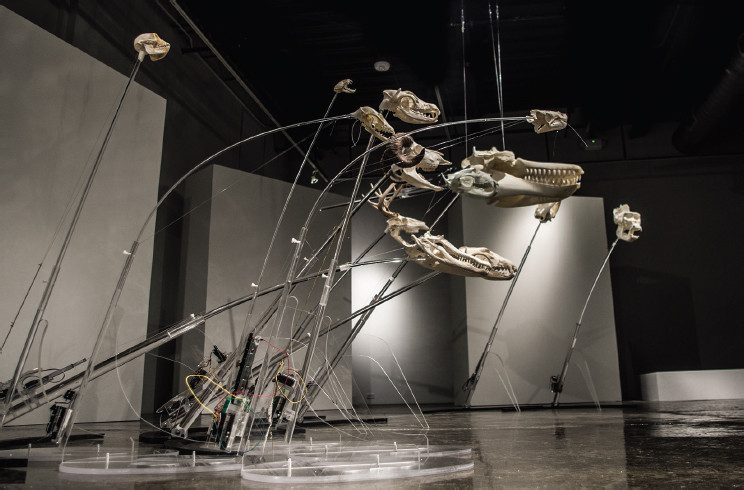
The Very Loud Chamber Orchestra of Endangered Species
Pinar Yoldas
SOURCE: https://stamps.umich.edu/creative-work/stories/pinar-yoldas
Pinar Yoldas is a Turkish artist and scholar who works with the medium of speculative biology. In The Very Loud Chamber Orchestra of Endangered Species, she addresses the impact of anthropogenic forces on non-human animals. She takes skulls from endangered species and outfits them with tubes that push air through the skulls. In so doing, she works with the acoustics of their bone architecture, creating an orchestral arrangement of sounds. She writes, “By literally giving a VOICE to those whose habitats and lives are jeopardized by human activities, the project will initiate a subliminal emotional dialogue between viewers and the life forms that they often overlook. In essence, this project is an audible attempt to restore the dignity of other organisms that inhabit this planet and is an aesthetic amplifier of the negative consequences of our cultural choices. Alternatively, this project can be understood as a memento mori for those whose existence has been threatened, and a roaring wake-up call to the human race.”
IMAGINING CLIMATE CHANGE THROUGH FOOD
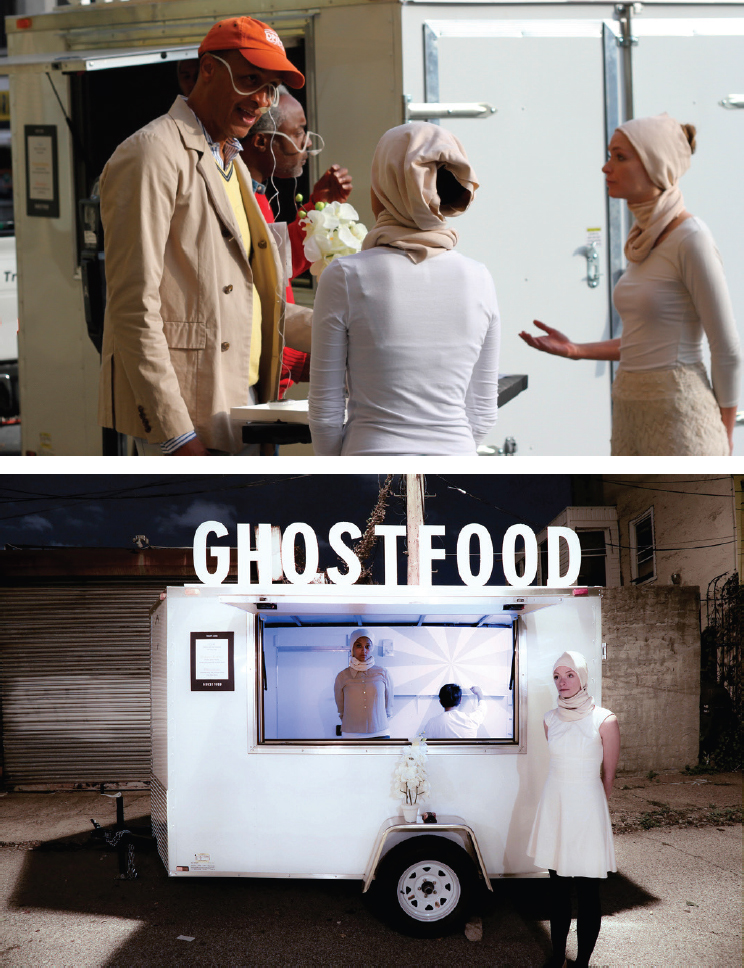
Ghost Food
Miriam Simun (MIT Media Lab) and Miriam Songster (Artist)
Images: courtesy of the artists
SOURCE: http://xsead.cmu.edu/works/115; http://www.miriamsimun.com/ghostfood/
Ghost Food is a mobile food truck that puts together sense and food pairings using a wearable device that helps engage smell. Scents of foods threatened by climate change are paired with foods made from climate change-resilient foodstuffs, to provide the taste illusions of foods that may soon no longer be available. Ghost Food staff serve the public, guiding visitors through this pre-nostalgic experience and engaging dialogue. Ghost Food has been deployed in Newark and Philadelphia thus far.
EXPLORING SOCIAL DISCRIMINATION THROUGH INTERACTIVE NARRATIVE AND GAMING TECHNOLOGY
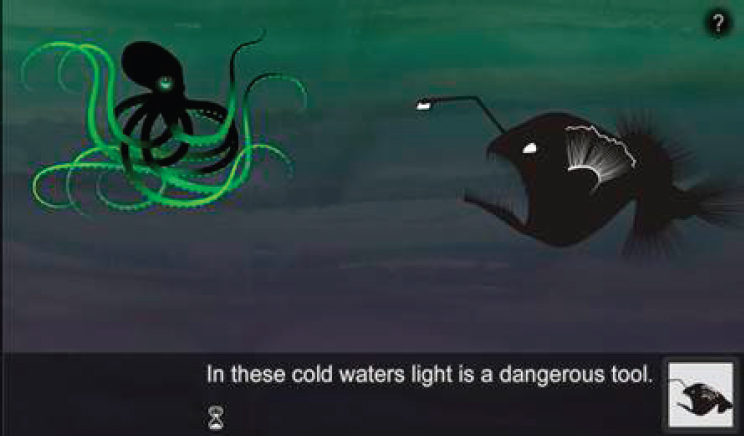
Mimesis
D. Fox Harrell (Massachusetts Institute of Technology)
Video game technology and the creation of educational programs that utilize it is on the rise. This work by D. Fox Harrell at MIT is created to explore the idea that social networks and video game components can be used to help people better understand and create empathy, deliver meaningful experiences and enable critical reflection on identity. According to the Mimesis website, “The story of Mimesis takes place in an underwater setting with subtly anthropomorphized sea creatures as characters. The player character is a mimic octopus, which is a species of octopus adept at emulating other creatures. The octopus is on a journey that takes it from the dark depths of the ocean to its home in the tropical shallows. Along her way, the octopus will encounter several sea creatures who inhabit the waters and whose actions serve as examples of particular kinds of covert discrimination. These sea creatures provoke the octopus, leaving the player to must choose between different emotional responses to the creatures in order to guide the octopus through a series of short conversations. In this way, the project maps the experience of discrimination onto gameworld based on an underwater metaphor.”
COMMUNITY, SKATEBOARDS, AND MOTION DATA CAPTURE
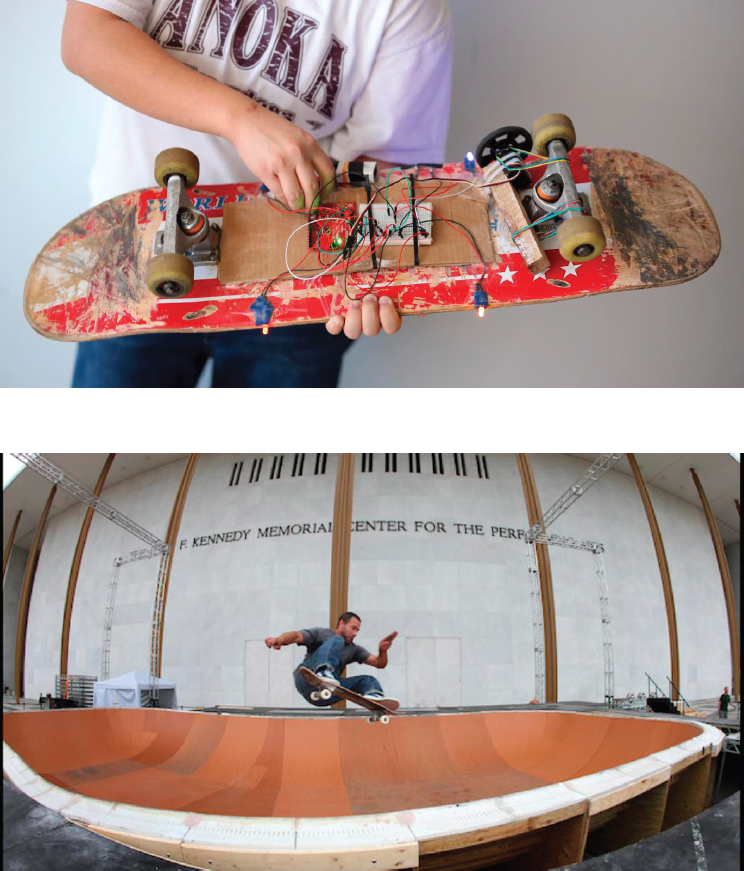
Gallaudet CRATERs: Finding a Line
Max Kazemzadeh, Dave Mutarelli, Ben Ashworth, Garth Ross, Dr. Dave Snyder
Gallaudet University and the Kennedy Center for Performing Arts
Photo credit: Max Kazemzadeh (Top); John Falls (Bottom)
CRATERS stands for Collaboration Research, Art Technology, Engineering, Robitics and Skateboarding. The Gallaudet CRATERs: Finding a Line Bowl was initially built by Dave Mutarelli (Lifetime Decks LLC) and Ben Ashworth (Sculpture Faculty at George Mason University) as commissioned by the Kennedy Center for Performing Arts. The Kennedy Center’s “Finding a Line” event was led by its VP for Community Engagement, Garth Ross, who hosted a number of professional skateboarders, musicians, artists, and the public to skate and create together in the Center’s front yard. After the event, the Kennedy Center donated the bowl to Gallaudet University in order to serve the creative, academic, and collaborative initiatives that began with a Special Topics course designed and taught by Gallaudet Associate Professor Max Kazemzadeh’s titled “Skateboarding, Tracking & Data Visualization.” The integrative course is supported by a NASA Space Grant initiated by Gallaudet Chemistry & Physics Professor Dr. Dave Snyder.
SCIENCE PRACTICE AND TOOLS IN ART SCHOOLS
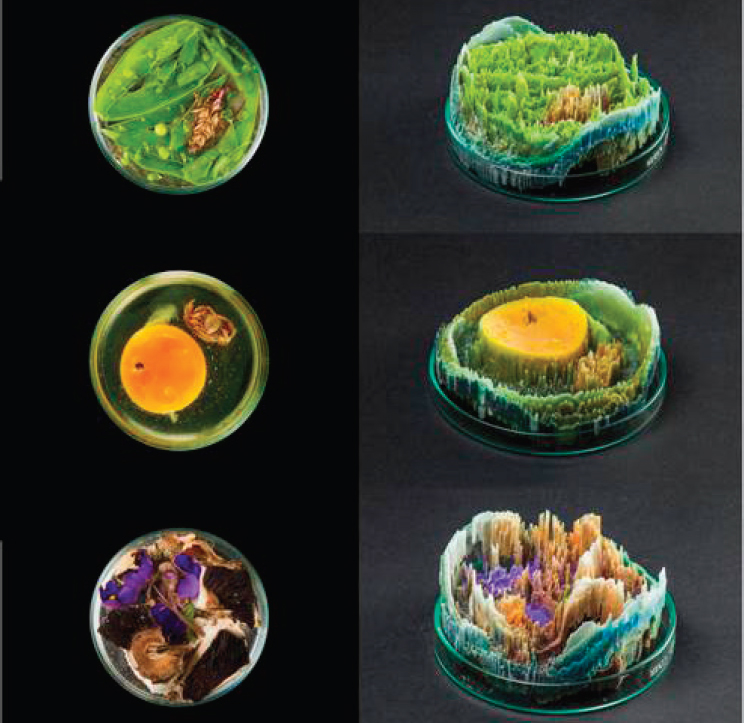
Vanitas (in a Petri dish)/Remote Sensing
Suzanne Anker (School of Visual Arts, NYC)
The Bio Art Lab is a fully functioning science lab housed within an art school. It was founded in 2011 as part of the School of Visual Arts’ BFA Fine Arts facility in Chelsea, NYC. The Lab was founded and is directed by Suzanne Anker, Chair of the BFA Fine Arts Department. Conceived as a place where scientific tools and techniques become tools and techniques in art practice, the Lab provides a space for artists to investigate aspects of the biological sciences such as evolution, artificial life, and robotics through digital sculpture and new media installations.


























